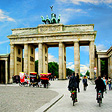CHARLOTTENBURG PALACE - BERLIN
The “Old” Palace - Crown Jewels and Porcelain
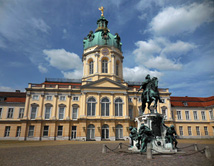 The Charlottenburg Palace and the city district surrounding it gets its name from Sophie Charlotte, the wife of Frederick III, the Elector of Brandenburg, who crowned himself as Frederick I, King of Prussia in 1701. The project began as a residential palace for the ruling elector and his wife, who was a driving force behind its initiation, with architect Johann Arnold Nering commissioned to build it. The main palace of the ruling Prussian Hohenzollern dynasty (see Castle Hohenzollern) was in the center of Berlin across from the Berliner Dom cathedral where many of the Hohenzollerns are buried (see Berliner Dom Crypt), but that palace now longer exists, bombed to rubble in WWII. It is currently being rebuilt, in that large construction project on the Under Den Linden. The Charlottenburg Palace remains as the best surviving palace of its time in Berlin, in the Charlottenburg- Wilmersdorf district just to the west of the city.
The Charlottenburg Palace and the city district surrounding it gets its name from Sophie Charlotte, the wife of Frederick III, the Elector of Brandenburg, who crowned himself as Frederick I, King of Prussia in 1701. The project began as a residential palace for the ruling elector and his wife, who was a driving force behind its initiation, with architect Johann Arnold Nering commissioned to build it. The main palace of the ruling Prussian Hohenzollern dynasty (see Castle Hohenzollern) was in the center of Berlin across from the Berliner Dom cathedral where many of the Hohenzollerns are buried (see Berliner Dom Crypt), but that palace now longer exists, bombed to rubble in WWII. It is currently being rebuilt, in that large construction project on the Under Den Linden. The Charlottenburg Palace remains as the best surviving palace of its time in Berlin, in the Charlottenburg- Wilmersdorf district just to the west of the city.
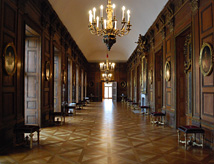 The Palace of Charlottenburg (Old Palace) was succeeded in scale and opulence by the constructions of Frederich II (aka Frederick The Great) in his massive palaces and grounds further to the west in Potsdam, called the New Palace (Neues Palace), which rather overshadow Charlottenburg, but the “old” palace remains one of the most beautiful and fascinating. In Charlottenburg, the feeling of the lived-in royal palace remains, and it is here you can see the Prussian Crown Jewels of the Hohenzollerns, the line of many competing electors who later became the Emperors of the 2nd Reich, the later golden age of German wealth and power from the 18th Century until the end of World War I, when the last German Emperor Wilhelm II, saw the end of imperial glory in the muddy trenches of the Marne.
The Palace of Charlottenburg (Old Palace) was succeeded in scale and opulence by the constructions of Frederich II (aka Frederick The Great) in his massive palaces and grounds further to the west in Potsdam, called the New Palace (Neues Palace), which rather overshadow Charlottenburg, but the “old” palace remains one of the most beautiful and fascinating. In Charlottenburg, the feeling of the lived-in royal palace remains, and it is here you can see the Prussian Crown Jewels of the Hohenzollerns, the line of many competing electors who later became the Emperors of the 2nd Reich, the later golden age of German wealth and power from the 18th Century until the end of World War I, when the last German Emperor Wilhelm II, saw the end of imperial glory in the muddy trenches of the Marne.
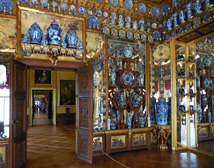 The original palace was called Lietzenburg for the district where it was located on the site of an earlier noble house now vanished to history, and consisted of one linear wing of two and a half stories with the distinctive cupola which still forms the broad formal façade of Corinthian decorative columns. At the rear of the wing were two great halls in oval shape with the upstairs hall for ceremonies and the lower hall looking out on the formal gardens.
The original palace was called Lietzenburg for the district where it was located on the site of an earlier noble house now vanished to history, and consisted of one linear wing of two and a half stories with the distinctive cupola which still forms the broad formal façade of Corinthian decorative columns. At the rear of the wing were two great halls in oval shape with the upstairs hall for ceremonies and the lower hall looking out on the formal gardens.
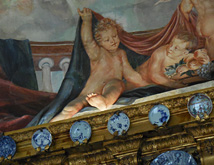 The palace was dedicated in July of 1699, but in anticipation of his ascension to a king’s title, and not satisfied with a single wing as of sufficient scale for his new stature and place among ruling families of Europe, the king sent his royal architect, Johann Frederich Eosander von Göthe, to study the French royal country palace of Versailles and Italian Palaces (see Colorno) to design a grander palatial edifice. He began his expansion of the barely completed original structure in 1702, extending the main wing and adding two full side wings to enclose a courtyard, but before the palace could be completed, Queen Sophie Charlotte died in 1705, and Frederick renamed the palace in her memory.
The palace was dedicated in July of 1699, but in anticipation of his ascension to a king’s title, and not satisfied with a single wing as of sufficient scale for his new stature and place among ruling families of Europe, the king sent his royal architect, Johann Frederich Eosander von Göthe, to study the French royal country palace of Versailles and Italian Palaces (see Colorno) to design a grander palatial edifice. He began his expansion of the barely completed original structure in 1702, extending the main wing and adding two full side wings to enclose a courtyard, but before the palace could be completed, Queen Sophie Charlotte died in 1705, and Frederick renamed the palace in her memory.
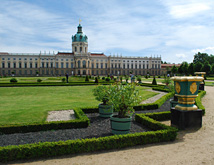 Aside from the crown jewels and collection of silver (this section is being renovated until the end of 2015), the most remarkable chamber of the Charlottenburg Palace is the Porcelain Cabinet Room, filled in every corner with the collection of Hohenzollern Porcelain. The upper floor features the lavish Throne Room, the Banqueting Hall, and the Golden Gallery, and throughout, the palace holds one of the largest collections of French 18th Century painting. The new wing of the palace features the State Apartments of Frederick the Great (Frederich II) in rococo style. A Hohenzollern mausoleum was added on the grounds of the palace, where a few of the family are buried. A succession of the family lived and added to the palace through 150 years until the last to live there, Frederich III in1888. The Charlottenburg Palace was heavily damaged by bombing in the war but rather than being bulldozed as the state palace in East Berlin was during the years of the GDR, the Chartlottenburg Palace was rebuilt.
Aside from the crown jewels and collection of silver (this section is being renovated until the end of 2015), the most remarkable chamber of the Charlottenburg Palace is the Porcelain Cabinet Room, filled in every corner with the collection of Hohenzollern Porcelain. The upper floor features the lavish Throne Room, the Banqueting Hall, and the Golden Gallery, and throughout, the palace holds one of the largest collections of French 18th Century painting. The new wing of the palace features the State Apartments of Frederick the Great (Frederich II) in rococo style. A Hohenzollern mausoleum was added on the grounds of the palace, where a few of the family are buried. A succession of the family lived and added to the palace through 150 years until the last to live there, Frederich III in1888. The Charlottenburg Palace was heavily damaged by bombing in the war but rather than being bulldozed as the state palace in East Berlin was during the years of the GDR, the Chartlottenburg Palace was rebuilt.
Visiting Charlottenburg Palace
Opening times are 10am to 6pm Tuesday to Sunday from April to October and 10am to 5pm from November to March. The palace is closed on Monday and Wednesday. Last admission is 30 minutes before closing. © Bargain Travel EuropeFind best hotel and vacation deals in Berlin on TripAdvisor
Web
Info
Charlottenburg
These articles are copyrighted and the sole property of Bargain Travel Europe and WLPV, LLC. and may not be copied or reprinted without permission.
See Also:
RICHARD WAGNER PLATZ U-BAHN STATION

